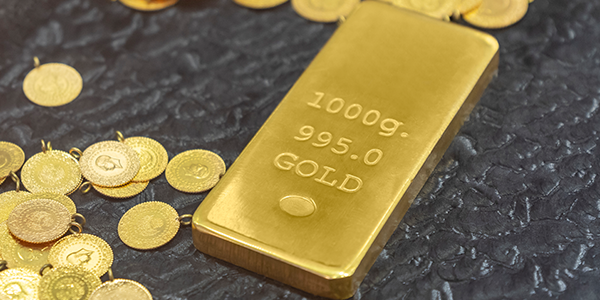by Frank Holmes, CEO, CIO, U.S. Global Investors
Investors, in fact, may be pricing in an economic downturn.
Below is the Wilshire 5000 Total Market Index divided by U.S. gross domestic product (GDP). Named for legendary investor Warren Buffett, who once called the ratio the best gauge of stock valuations, the “Buffett indicator” has also served as an interesting leading indicator. As you can see, valuations have historically peaked and then started to roll over between three and five quarters before a recession took place, the one exception being the pandemic-triggered recession in 2020. We’re currently seeing the indicator reverse course, but the difference this time is that stocks have never been so overvalued compared to the U.S. economy, making the risk even greater.
There are a number of things investors can do in advance of a possible recession, and that includes having exposure to physical gold as well as gold mining stocks. Both asset classes have historically helped investors offset potential market losses, and I believe there’s good reason to believe they may do so again.
Gold Has Been Up in Three of the Four Past Market Routs
Take a look below. Going back 40 years, in every instance when the S&P 500 has fallen into a bear market—that is, when it fell more than 20% off its recent peak—physical gold and gold mining stocks have outperformed, by as much as 41 basis points in the case of gold stocks during the dotcom bubble in 2000. The price of the yellow metal, meanwhile, delivered positive returns in all but one occasion, and that’s when the whole world shut down in response to the onset of the Covid-19 pandemic.
Past performance is no guarantee of future results, of course, but I still like gold and gold stocks as a potential hedge against recessionary risk.
In more recent years, gold has had to compete with Bitcoin as a store of value. I also like Bitcoin, but unlike its digital cousin, gold has a centuries-long track record and enjoys near-universal trust and acceptance. Gold also has lower volatility than Bitcoin, is held by dozens of central banks and remains one of the most liquid assets on earth. In 2021, the precious metal did more than $130 billion in trading volume every day on average. Only euros, pound sterlings, U.S. Treasuries and S&P 500 stocks traded more.
We have a history as pioneers in gold mining investment, and our team brings valuable background in geology and industry finance.
That said, we’re proud to offer mutual fund investors two ways to invest in gold mining stocks: the Gold and Precious Metals Fund (USERX) and World Precious Minerals Fund (UNWPX). While USERX focuses chiefly on the largest gold and precious metal miners, often called the “seniors,” UNWPX provides increased exposure to junior and intermediate explorers and producers for added growth potential.
In the first quarter of the year, both funds performed exactly as they were designed to perform. While the market fell 4.6% in the first three months, our gold funds delivered positive returns, with UNWPX increasing 1.9% and USERX up 10.3%.
Expense ratios as stated in the most recent prospectus. Performance data quoted above is historical. Past performance is no guarantee of future results. Results reflect the reinvestment of dividends and other earnings. For a portion of periods, the fund had expense limitations, without which returns would have been lower. Current performance may be higher or lower than the performance data quoted. The principal value and investment return of an investment will fluctuate so that your shares, when redeemed, may be worth more or less than their original cost. Performance does not include the effect of any direct fees described in the fund’s prospectus which, if applicable, would lower your total returns. Performance quoted for periods of one year or less is cumulative and not annualized. Obtain performance data current to the most recent month-end at www.usfunds.com or 1-800-US-FUNDS.Gold, precious metals, and precious minerals funds may be susceptible to adverse economic, political or regulatory developments due to concentrating in a single theme. The prices of gold, precious metals, and precious minerals are subject to substantial price fluctuations over short periods of time and may be affected by unpredicted international monetary and political policies. We suggest investing no more than 5% to 10% of your portfolio in these sectors.The S&P 500 is a stock market index that tracks the stocks of 500 large-cap U.S. companies. The Philadelphia Gold and Silver Index is an index of thirty precious metal mining companies that is traded on the Philadelphia Stock Exchange. The Wilshire 5000 Total Market Index, or more simply the Wilshire 5000, is a market-capitalization-weighted index of the market value of all American-stocks actively traded in the United States.Gross domestic product is a monetary measure of the market value of all the final goods and services produced in a specific time period by countries.















